|
TennisOne Lessons The Forehand Volleyby Corky Cramer
Most teaching pros agree that, technically speaking, the volley is the simplest shot of all. Yet for so many students, it is the most difficult part of the game to master. Obviously, different players have their own approaches to learning the game. Some tend to learn logically or geometrically, while others excel through visual imagery and rhythms. No matter what the learning style, however, the approach to teaching the volley should be based on the actual underlying reality of the stroke. Thanks to the advent of digital photography we are able to examine that reality more closely. This sheds new light on some key concepts, and challenges some of the most common descriptions used in teaching the volley. The Punch
For decades coaches around the world have been trying their best to get students to hit the ball out front and "punch" their volleys. "Punch the volley" is a prime example of how teaching language can mislead us when it does not conform to reality. If you have achieved a punching motion I can assure you that you are still trying to find that elusive volley. I believe when we send our brain a message, we then try to follow that message. This is why semantics are so important in teaching. As the animation with the boxing glove demonstrates, an actual punching motion bears very little or no resemblance to a good forehand volley. The initial movement of a punch comes from pulling the arm back, similar to drawing a bow, and at the same time, loading up energy on the back foot. No doubt this will generate power in delivering a blow. But note what actually happens with the punch. The hand leads the motion with the knuckles and the thumb on top. As the punch is delivered, the knuckles continue forward, so the follow through is across the body and down.
If you were to put a racquet in your hand and simulate this action, you would see the racquet face turn totally downward, making it impossible to get the ball over the net! In all fairness to my fellow pros I¹m sure this is not the action they are trying to have you develop so please stop trying or you¹ll punch yourself silly! Give Yourself a HandNow that we know the volley is NOT A PUNCH, what actions can we most liken it to? Sit back and give yourself a round of applause if you came up with a clapping motion.Contrary to popular belief (and the punching analogy), the hands do not extend away from the body toward the ball on a good forehand volley. Rather the hands move from the outside in. They start outside the width of the body and move back towards to center--very much like a clapping motion. The clapping motion allows for the generation of power, and at the same time maintains a constant racquet face angle. This is the opposite of the punch which turns the racket face over and down.
Note: In the clapping motion the hands come to a sudden stop. In tennis terms this means no follow through. This motion will allow the ball to rebound off the strings quickly. Now you can take one hand away and do the same thing. The image of the "one hand clap" will intentionally bring your hand to an abrupt stop. For those of you who spend time working out with weights, this is very similar to the exercise known as the "fly," which develops your pectorals and is a great way to beef up the strength of your forehand volley. The stronger your forearms, pecs, and hands, the wider apart you can position your hands to begin your standing ovation. The Contact Point
Typically, students are advised to make contact "out in front" of the body. Again, I think there is an important semantics issue here, which can again cause players to send their brains the wrong message. Note: I am not making contact "out front," but rather equal to about the middle of my body. This enables me to keep on balance and maximize my strength and accuracy. Alignment
The alignment of the body and the stance are the keys for directional control. To hit crosscourt, the stance is more open. This means my racket head will be traveling on a crosscourt line at contact.
In order to hit a crisp down the line shot, however, I have to turn my entire body further, so that the palm of my hand (when in the clapping motion) is pointed down the line. Most players have more trouble turning on the forehand volley than on any other shot. There is an almost irresistible tendency to let the hands separate and immediately take the racket back with the arm. One of the best ways to help develop a great forehand volley turn is with the aid of a pair of handcuffs. Once you're "cuffed" you will instantly find it necessary
The Mirror EffectAnother way to understand a world-class volley is to look at it as a reflection. Properly set, the angle of the racquet face reflects the ball on an angle for the target. This means that the racquet face must be presented facing the target zone before, during, and after contact.
A common tendency for the club player, however, is to present the racket face directly to the line of the incoming ball, rather than on a line to the target When confidence is an underlying issue, presenting the racquet face flat to line of the incoming ball will insure making contact. But it will not allow the volley to do its job which usually is to end the point. Instead it will return the ball directly back to your opponent. How many of you have said to yourself or coach "I can¹t figure it out but in matches I just keep hitting the ball right back to my opponent." The only way to redirect the ball in this case is to change the angle of the racket in the middle of the motion to the ball. This requires perfect timing and is why swinging volleys are not a great idea below the world class level.
As one of the top coaches in Canadian history, he developed over 50 players who won national titles, and coached over a dozen Davis Cup and Fed Cup players. A 25 year USPTA member, Corky is also a board member for The Advanced Tennis Research Project ( www.AdvancedTennis.com ). |
|||||||||||

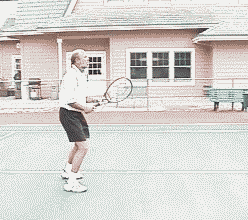
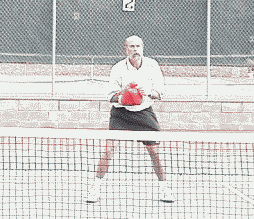
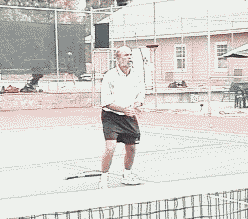
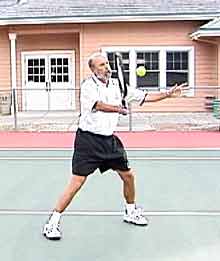
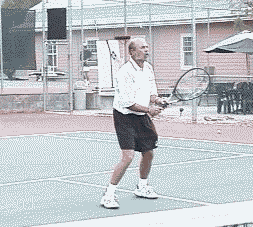
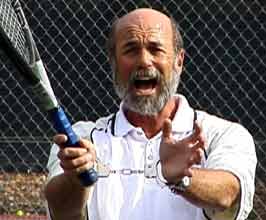
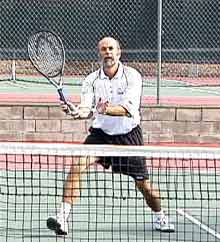
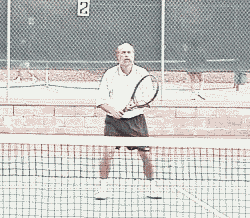
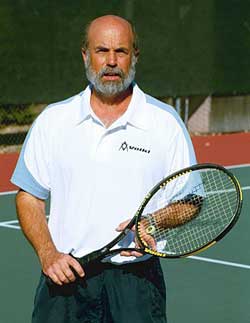 Corky Cramer, TennisONE contributing editor, is beginning a new series of articles from America's Great Teaching Pros. He is the Director of Tennis at the Montecito Heights Health and Racquet Club in Santa Rosa, California.
Corky Cramer, TennisONE contributing editor, is beginning a new series of articles from America's Great Teaching Pros. He is the Director of Tennis at the Montecito Heights Health and Racquet Club in Santa Rosa, California.